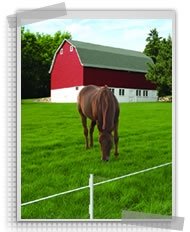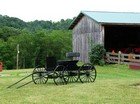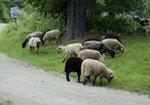Electric Fencing and Fence Maintenance for the Fall/Winter Season
Electric
fencing provides an
inexpensive alternative to standard wooden board fencing to contain
your
animals. While electric animal fences are relatively easy to maintain –
no need
to check for loose boards or dangerous nails sticking out, and no
annual
painting required – some basic maintenance is still necessary to keep
them
functioning effectively, particularly in preparation for the
fall/winter season
when electric fences often experience problems.
To verify that your electric
fence is working effectively you will need to walk the fence line
checking that
adequate voltage is passing along your fence wires by testing with a
voltage
meter. If power is dropping from your fence it can be due to any of the
following reasons.
Electric Fencing and Adequate Voltage for Livestock
Short Circuits in Electric Fencing

Any brush or grass that touches the fence will cause a short circuit, rendering the fence useless.
Consequently, to ensure that your fence remains free from vegetation it is essential to walk the fence line regularly to check vegetation growth, trimming back branches and overgrown vegetation where necessary. In fall dead branches may fall onto the fence wires and will drain power from the fence line unless they are removed.
Frozen Ground and Electric Fencing
During the winter months, when soil is dry or frozen, the charge emitted from an electric animal fence may gradually become weaker and the fence may even stop emitting a charge completely.
Moist soils are more conductive than dry soils, and as frozen soils have a low moisture content it reduces the ability of the charge to make contact with the grounding rods to complete the circuit that provides the shock to the animal when it touches the fence.
To rectify this you can install a ground-wire return circuit to your fence, which will facilitate better grounding to make your fence more effective during winter. You can do this by installing one or two additional wires that do not carry a charge to your fence – install one lower down on the fence and one higher up the fence – then connect these uncharged wires to the grounding system of your electric fence circuit.
When an animal makes contact with a charged wire and an uncharged wire of your fence, the uncharged wire replaces the frozen soil to serve as the return circuit, shocking the animal.
Heavy Snowfall and Electric Fencing
If you live in an area that is prone to heavy snowfalls it may be prudent to install a cut-off switch that will allow you to disconnect the lower wires of your fence to prevent this from occurring. The wires higher up the fence will still be able to conduct an electric current to contain your animals securely without the power being drained by the lower snow-covered wires at the base of the fence.
Solar Chargers and Electric Fencing
If this is going to be tricky in inclement weather then it may be wise to invest in an alternative power supply, such as a backup battery (and battery charger) that can be charged off-site and used as a replacement battery while the other one is being charged.
By checking your fence regularly to ensure that it is well grounded, that fence wires are free from fallen branches and snow drifts, and that the fence line is adequately powered, you will have peace of mind knowing that your livestock remain safely contained throughout the winter season ahead.
Electric Fence Supplies
Did you find this page helpful?
Sharing is a way of saying, "Thanks!"
Follow Us and Keep Up to Date
Don't miss out on our latest news and articles. Sign up for our free monthly e-zine!
Go from Electric Fencing back to Do It Yourself ProjectsGo to Farm Gates







New! Comments
Do you have something of value to add? Leave me a comment in the box below.